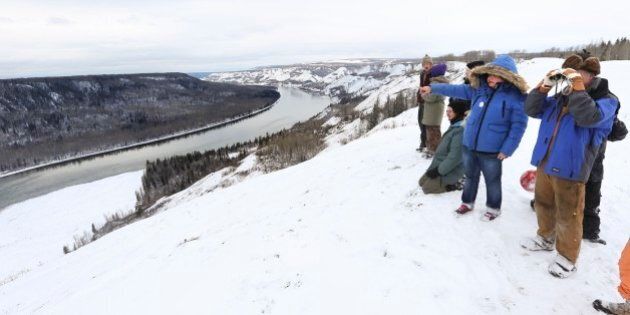
Premier Christy Clark has ambitious plans for the copious amounts of electricity -- far more than British Columbia is expected to need for more than a decade -- generated by the Site C dam on the Peace River: sell it to Alberta.
In a recent interview with Alaska Highway News, Clark said the power from the Site C dam, scheduled to come online in 2024, could potentially provide electricity to Alberta -- where the government has recently committed to closing all of its coal-powered energy plants.
"We could potentially electrify the oilsands, which would make the oilsands the cleanest oil produced anywhere on the globe," Clark said. "If Canada wants to make an argument for our resources to find their way to market, let's make them the cleanest in the world and let's make that our brand."
"Here we have a government floundering for a market while they go ahead building the project."
Need for Site C Unproven
Clark's suggestion that Site C may power the oilsands shines a spotlight on the B.C. government's ever-changing rationale for building the project.
Ken Boon, a Peace Valley farmer who lives on family land that will be flooded if the dam is built, said he finds the prospect of prime agricultural land being destroyed to supply the oilsands with electricity "very disturbing."
"It highlights that they don't have a market for the Site C power," Boon told DeSmog Canada. "So here we have a government floundering for a market while they go ahead building the project."
In its final report, the federal-provincial panel tasked with reviewing the Site C dam said that, due to the severe environmental impacts of the project, the project should not proceed unless there is an unambiguous need for the power.
"Electrifying the oilsands doesn't seem like a demonstrated unambiguous need," Boon said.
Harry Swain, chair of the Joint Review Panel that reviewed Site C, said B.C. Hydro never mentioned Alberta as a potential market for the dam's power in its application.
"One recognizes that things change over time, but this has an air of desperation," Swain told DeSmog Canada.
"In the rationale for building the dam, B.C. Hydro put forward load forecasts that included a fair amount of electricity for the LNG industry and continued growth in other industrial, commercial and residential demand. Well, the truth is that since 2008 demand has been falling, not rising," he said.
As DeSmog Canada recently reported, B.C. Hydro's records show that without an expanded natural gas export sector, there is no demonstrable need for the Site C dam.
B.C. Hydro anticipates domestic energy consumption won't surpass domestic energy supply until 2028, at the earliest.
According to B.C. Hydro's estimates, major industrial users of electricity, such as the pulp and paper industry, will use less energy than previously thought -- partially because the cost of electricity will increase 28 per cent over the next five years, in part to pay for the Site C dam.
A DeSmog Canada investigation revealed B.C. Hydro is in fact paying independent power producers not to produce electricity due to an oversupply problem.
"The case that we need this power by 2024 was not made then, and is in even worse shape now," Swain said.
He added that electrifying the oilsands would require new transmission lines and likely a new regulatory process with Alberta.
"It does not appear to be a practical alternative," he said.
"It's residential schools. It's smallpox in blankets. Now it's energy development. It's criminal. They should be held accountable for the damages."
Destination for Site C Power a Moving Target
B.C. LNG projects have been delayed, labeled unprofitable, caught up in land disputes and lack committed investors -- hence Clark's wandering eye.
"I think... we want to have as many customers for B.C. Hydro product as we can," Clark told the Alaska Highway News.
Clark added that exporting power "allows us to lower rates for people who live here," but did not make mention of B.C. Hydro's plan to raise hydro rates until at least 2019.
Clark also didn't mention that Site C's power is going to cost $80 to $90 per megawatt hour to produce, but the pool price for electricity in Alberta right now is hovering at around $30 per megawatt hour.
Site C is 'Cultural Genocide': Chief
West Moberly First Nation Chief Roland Willson said Clark's suggestion that Site C might be used to electrify the oilsands is absurd.
The purpose of Site C "is a never-ending moving target," Willson said. "First it was for LNG, then it was to sell power to California, now it's Alberta."
He said recent revelations that B.C. Hydro is paying power producers not to produce highlights that there is no need for Site C.
"So it's absolutely ridiculous that we're destroying a valley to potentially sell the power to the Alberta tar sands now."
The West Moberly and Prophet River First Nations are currently fighting against Site C in court, arguing the project infringes on rights guaranteed by Treaty 8.
Willson said Site C will not pass the Sparrow test, a legal litmus test for determining if a government decision justifiably violates First Nation's rights, because there is no demonstrable need for the power it will produce.
"They're taking away from us what we value," Willson said, saying the effects of this project amount to "cultural genocide" for his community.
"It's residential schools. It's smallpox in blankets. Now it's energy development," he said. "It's criminal. They should be held accountable for the damages."
This article originally appeared on DeSmog Canada. With files from Emma Gilchrist.
Follow HuffPost Canada Blogs on Facebook
MORE ON HUFFPOST:
